It seems like silencer companies are coming out of the woodwork these days. Everyone and their brother makes cans — heck, my local FFL has a shop-built silencer they’re hawking. But while the basic design is simple enough making something that works, works well, and works well every single time is a challenge. It pays to have someone who knows what they’re doing at the helm, and in the case of Dead Air Armament they might have the best shot of any of the new silencer companies at making a big splash. Not only are they leveraging the engineering knowledge of Bergara Rifles to make their stuff, they’ve got Mike Pappas (formerly) of SilencerCo fame keeping them on the straight and narrow. Their first product being released shortly is the Sandman silencer, and I had an opportunity to test it out before anyone else.
As a preface, I just wanted to point out that this is not a typical TTAG review. Here at TTAG we usually reserve judgment until we’ve put a couple hundred rounds through something and tried it out in different conditions. Unfortunately the BATFE here in the U.S. prevents us from getting our hands on silencers for protracted testing unless we go through months of waiting, spend $200 per transfer, and live in certain states. It’s impractical. Luckily I recently had a chance to visit the folks at Dead Air Armament and test all of their cans under their supervision. While the tests may not be as extensive as a standard review, I feel that they (along with my experience in this field) were sufficient to allow me to form an opinion on the product.
Good silencer design starts on the inside, so let’s take a peek at how these things are made.
The design of the can is fairly bog standard when it comes to the baffle stack. The baffles are machined as two parts, a cone and a spacer, and then stacked together with other cones and spacers to form the main tube. The parts are then circumferentially welded together, and an outer tube is added to contain the whole assembly. Once the tube is complete and the mount system attached, the silencer goes on a wire EDM machine to ensure that the bore is concentric and exactly the right size to prevent baffle strikes.
This method of construction is nearly identical to the way most other major silencer companies do their cans. Heck, I remember seeing this same process when I first visited AAC and they were welding up some 762-SDN-6 cans. The reason it hasn’t changed very much is that it works, and it works well. The end result is a good can that will hold up well under use, and unless you’re looking for a featherweight silencer this is plenty good enough.
The real magic with the Sandman is the mounting system. When you get your Sandman, you also get a proprietary muzzle brake specifically designed to work with the can. The muzzle device has a tapered rear section that interfaces with a radius on the inside of the silencer, and provides not only accuracy but performance.
The larger surface area and precision machined parts interface together in exactly the same way each time, meaning any zero shift on the firearm will be repeatable — the can goes on the gun the exact same way in the exact same place every time. The larger surface area of that mounting surface also means that there’s more friction keeping the silencer from un-twisting, much like how SIG SAUER’s new line of silencers use a small radius to increase the surface area and friction and keep their silencers from un-screwing mid firefight. In Dead Air’s case it locks up the can tighter, so there’s no movement of the silencer to throw off your shots. Its as good if not better than a direct thread can in that it doesn’t freaking move.
That precision machined radius, which matches exactly between the can and the mount, also is great for keeping the silencer sealed. Unlike the 762-SDN-6 which has a tendency to throw some gas back in your face through the rear of the can, the Sandman series effectively seals the forward part so that there’s no gas leakage out the back. In the above picture you can see very clearly how the radiused base of the mount is slightly scratched up yet carbon free, while the baffles of the brake are as dirty as Miley Cyrus. That sharp delineation between the two areas is the effect of that friction-based seal.
When I first saw the silencer at work, I was very skeptical about the mount. I’ve been burned by ratchet mounts before (from SilencerCo too, chucking Sakers downrange like my name was Tim Tebow) and the idea of yet another ratchet based mount wasn’t making me happy. Then I learned a couple things.
First, the ratchet doesn’t actually work — its there to make people feel happy. When you twist the silencer in place, you’re screwing it down onto that radiused muzzle brake. When you’ve tightened it enough, the friction of that radius combined with the downward pressure from the threads on the rear of the can will keep it firmly in place. The ratchet was added just to make noise and keep end users from unscrewing the can too far.
Second, the whole assembly is replaceable. Dead Air are considering making other mounts available for the system, possibly including direct thread mounts that will be aftermarket adapters. So if your ratchet does ever wear out, you can just replace the whole thing and keep shooting.
All this I learned as they roped me into helping assemble the first batch of silencers off the line. So yeah, if you ordered a Dead Air Sandman and were one of the first to get them, I probably assembled your can. FYI.
The Sandman series comes in two flavors. The difference is in the lengths, the “S” which is 6.8 inches long (top of the article”in the white”) and the the “L” which adds two more inches (above in the usual black). The silencers are made with .30 caliber guns in mind, each rated up to .300 Win Mag but just as easily at home on a 300 BLK gun. They have one more trick up their sleeves though in the guise of a replaceable end cap. The gun ships with a 7.62 sized hole in the front end, but for those running a 5.56 gun you can get a 5.56 sized endcap as well for some added sound reduction.
Yeah. I did mention that they’re .300 Win Mag rated, right? This happens to be Mike Pappas’ personal Barrett MRAD in .300 Win Mag, and we put a ton of rounds through this thing while testing out the silencers. I’d definitely categorize it as “hearing safe” anywhere on that range, whether standing next to the gun or behind it. Even with the can installed, we were reliably and accurately hitting a 500 yard gong with ease all day long.
Honestly, while I used to be a bit of a suppression snob I’m coming down off that high horse. Highest dB reduction is nice and all, but if your product is hearing safe that’s plenty good for me. Even so the Dead Air guys still make those claims (31 dB reduction on the Sandman L for 7.62 NATO), but I have neither the materials nor the training to judge that independently. We’ve got a gal coming on staff who will put all that to the test shortly, so stay tuned.
What I do have is a bunch of cameras and some good audio recording equipment, so I leave it to y’all to judge for yourself.
In this video, I compare the Sandman S and the Sandman L on a 300 AAC Blackout rifle. And fail at life halfway through.
Shortly thereafter, I Shanghai’ed Mike Pappas and Cade into being my guinea pigs for some testing. The first thing I wanted to know was whether that extra 2 inches made a huge difference in the sound reduction. We used two identical 5.56 rifles for the testing, both with the 7.62 endcaps, and the results were… meh. There’s about half a note difference between the two, and while that’s definitely a result its not enough for me to plop an extra $150 on the table and add two more inches to my short rifle.
The next question was whether a 5.56 endcap on a 7.62 silencer actually made any difference. In this case, the answer was a resounding “yes.” There was a distinct difference in the sound and noise levels between a 7.62 endcap and a 5.56 endcap, which was a lot more than I expected. Not enough to make it no longer hearing safe, but definitely noticeable.
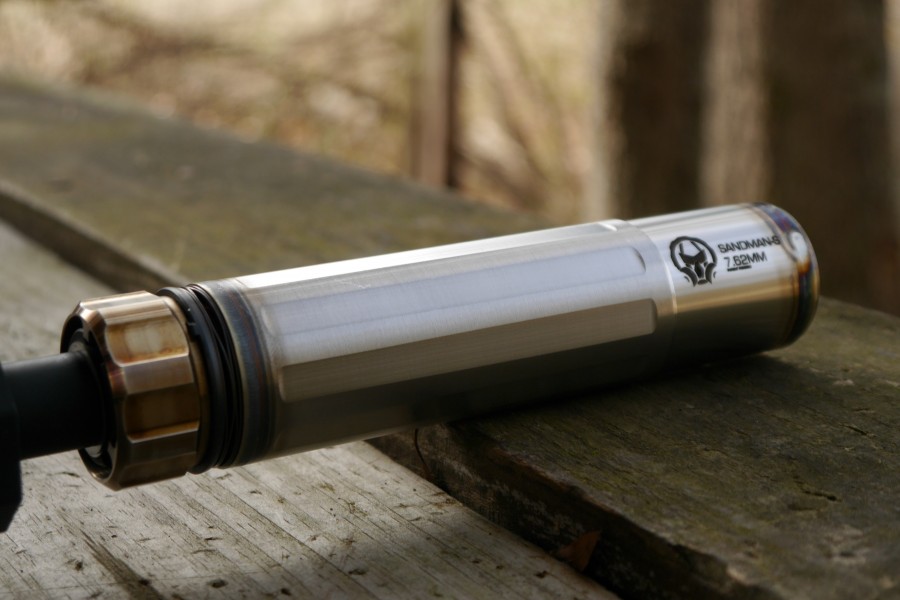
We shot these cans all day long, and at the end of the day I formed an opinion: I liked them. For three reasons.
The biggest thing for me is long term use. I abuse the heck out of my silencers, so they need to be able to hold up to whatever I throw at them. The reason I bought the Mystic-X was that it was easy to clean and replace parts if needed. The Sandman series is the same way, in that the only moving parts are easily replaceable and can be shipped straight to your door with no mucking about in NFA world. Beyond that, the locking system is designed so that you can remove and replace your silencer a nearly infinite number of times and ever have to worry about wearing out a ratchet or not having it lock up properly. It uses friction instead of a spring loaded pall to keep it in place, and I like that a lot. Not many ways that can fail, and that’s why SIG SAUER is using the same idea in their new line of cans.
Reason #2 is the ease of use. There are no “tricks” with this silencer, you just pop it on the end of your gun and crank it down. The mount is keyed so that it only ever goes on the gun one way, and even taking apart the mount itself is so easy you really don’t need a manual. The thing is idiot proof, which is ideal for my idiot friends.
The final reason is the overall design. The can has that same clean yet edgy look that AAC used on its silencers, and I really liked that aesthetic. I wish they would produce a few “in the white” like the shiny Sandman S I’ve been showing in the pictures, but all of the cans will come Cerakoted from the factory in a flat black. The silencer you see here is one that they literally grabbed off the production line so we could test it out, and I just liked the way it looked.
Dead Air Armament is kicking into high-gear as I type, producing the first couple runs of silencers for civilian sales. Personally, I’m a fan. The mounting system is nifty, the tech is up to industry standards, and they’ve actually thought about the entire product lifecycle when designing it so it can be serviced down the road. The only problem is going to be the price. At $1,050 for the S and $1,200 for the L, the cans bracket SilencerCo’s Omega but might not have all the same bells and whistles. The Omega is 2 ounces lighter than the S, has more mounting options, and comes from a well known company, but the Sandman series is full auto rated and can be safely used on much shorter barrel lengths. If you really want to bring out the big guns the SIG SAUER SRD762-QD has most of the same features as the Sandman S, is almost the exact same size and weight, but costs half as much ($695 MSRP).
For the shooter looking for “The One Silencer to Silence Them All,” there might be cheaper or better options on the market. But if you just need a really good and good looking .308 can, this is definitely worth a look.
Dead Air Armament Sandman S / L
Length: 6.8″ / 8.9″
Weight: 17.3oz / 21.8oz
Diameter: 1.5″
MSRP: $1,049 / $1,199
Ratings (out of five stars):
Sound Suppression: * * * *
There are other (reputable) silencers out there that post bigger numbers in the suppression department, but to me I didn’t really notice a difference. Its good.
Build Quality: * * * * *
I’ve got no complaints about the quality of their product. The mounts feel chunky and solid, and the tube itself seems durable enough for years of use in the field.
Ease of Use: * * * * *
Twist on, twist off. Just make sure you give it some force.
Overall Rating: * * * *
The product is solid, but the problem is the competition. They’re beaten on price from some competitors, beaten on features from others, and generally seem to fall into a “middle of the pack” area. When looking objectively for the average shooter, that is. For me, I really like it. It offers some great specs and some even better aesthetics. And I’ll be buying one when it hits the shelves over at Silencer Shop.


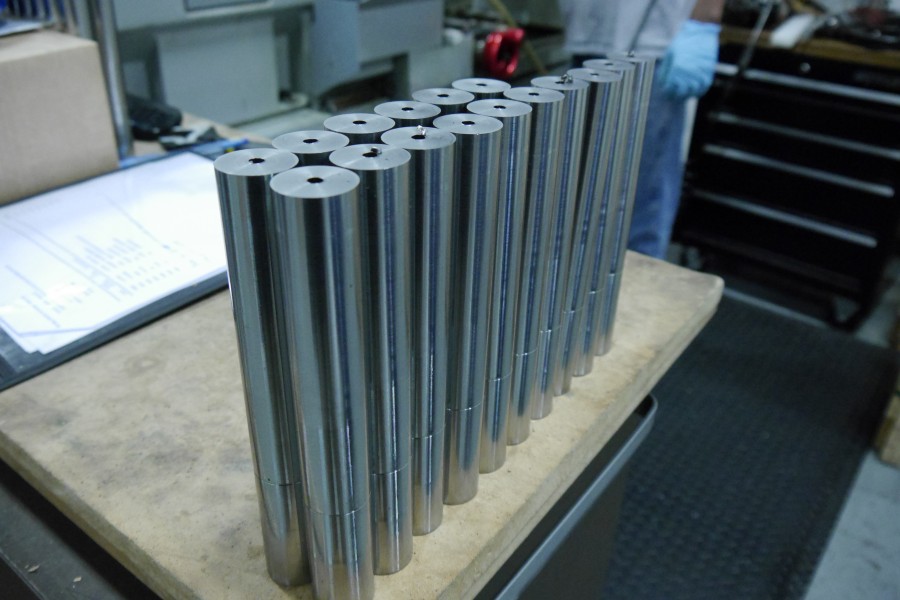
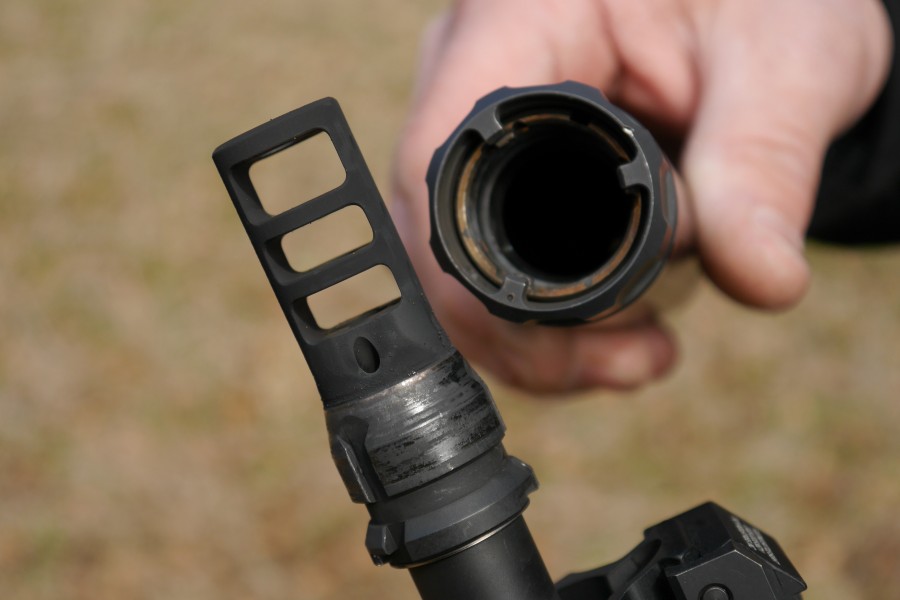
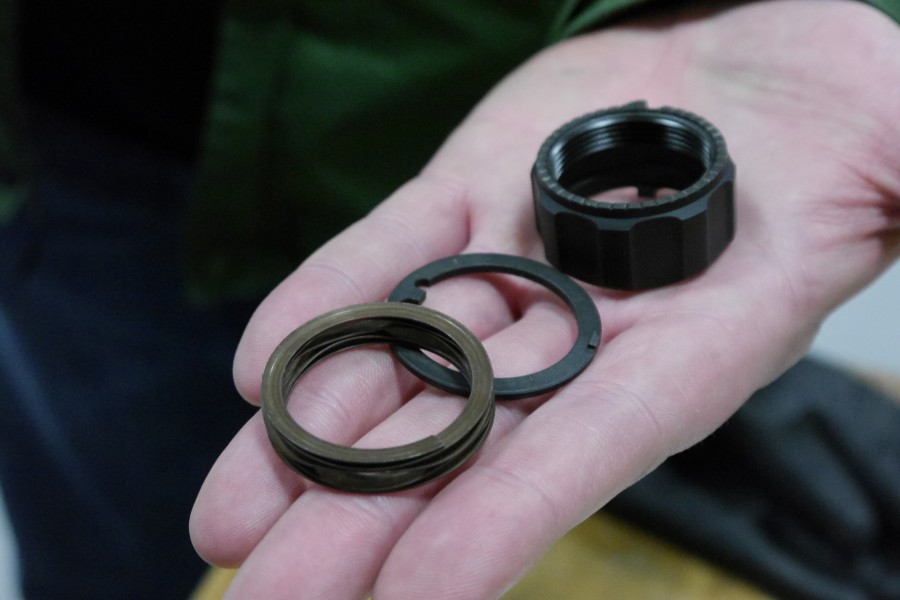


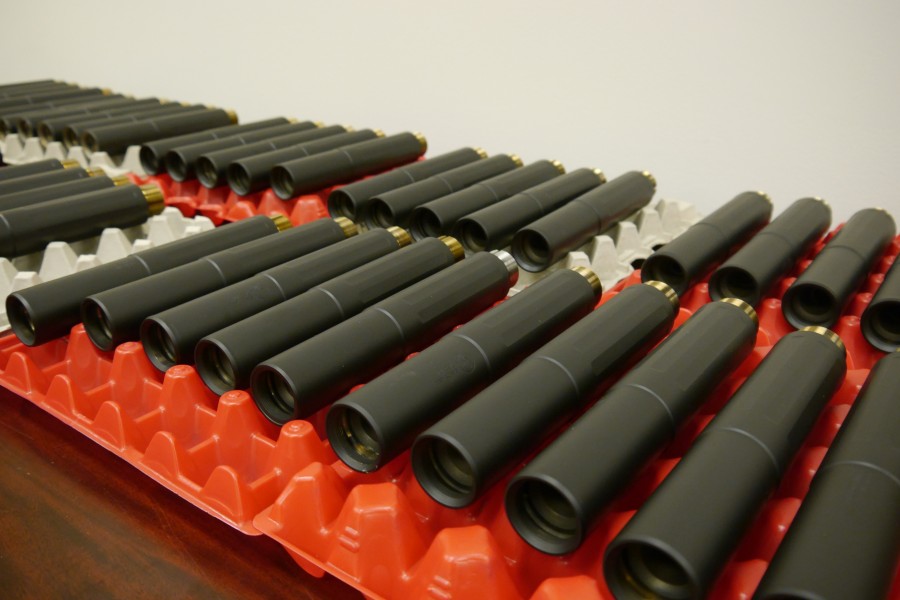



I got to see and shoot these with Cade at the QRF Earth Day Suppressor Shoot Saturday, have to say I was impressed by everything about it.
Street price is much closer to the Omega.
They are running $850-$980 at Silencer Shop, so the price isn’t that bad.. basically in the Omega/Saker/SDN-6 range. You have to remember that a lot of the cheaper silencers aren’t rated for full auto, don’t include mounts or QD capability, don’t have replaceable front caps, etc. The Sandmen are fully featured.
The Sandman laughs at Omega’s barrel length requirements. And full auto/temperature limits.
@Aaronthebaron, SIG laughs at the Sandman’s price.
None of these really sell at MSRP anyway. EVERY silencer manufacturer has a high MSRP. Sig just set theirs to match street price. It’s just marketing.
I’m still trying to find exactly what the barrel length requirements are. I want to chop the barrel on Scar 17 to 13″ and want a top notch suppressor for this application. Will the Sandman-L or Sandman-S do this?
Both should be fine.
Nick I am interested in a breakdown of how you chucked a Saker down range. I am on the verge of breaking down and getting a can within the next year and a Saker 7.62 among was on the shortlist, very keen to hear where it failed for you. Like you mentioned above, don’t care too much about db’s beyond hearing safe, but a shoddy mount will be a non-starter for me.
The QD mount isn’t very well designed, in my opinion. The petal design for the locking lugs is cool and everything, but it doesn’t appear to be very solid.
So what does this do better than the new SIG silencer line as they appear to be at a smaller price point and a similar locking system?
Was wondering exact same thing. I dont recall the SIG units having swappable end-caps (though I could be wrong on that). Other than that, not really sure.
Yeah Im still not sure what an end cap is worth? This being over 1000$ where the SIG line has some in the 700$ range are end caps going to be that big of a thing? Then you have to tack on the additional 200$ and PITA that is the NFA system i don’t see why this is going to sell any better than SIGs line. Not trying to be a fan boy, I just need a little more than “end caps” to get me to throw 300$ more at a product.
As much as I like the SIG SAUER silencers, they are a bit… industrial. The Sandman line has a more polished exterior. Also, the QD version of the SIG SAUER line can’t be easily manipulated if the handguards extend over the can — you need to push a tab to release the can. The Sandman series can be installed and removed without needing to manipulate the mount directly, so extended handguards or rails are good to go.
Thanks for the review, Nick. More competition with mounts that work is a good thing.
Same old same old. Until someone deploys the R&D funding to do a silencer properly, it’s a continuous polishing of a turd. Current silencers are still much akin to carburetors – no matter how high tech you make them, they’re just not very good at the intended purpose.
I’ve written the treatise before, so I won’t beat the horse again. I guess as long as people keep buying these marketing-driven cans, nobody will actually make one driven by performance and built with actual science.
You can do flow studies-modeling out the wazoo.
As long as the cost of prototyping remains what it is, this is what you’re gonna get.
Prototyping costs very little more than manufacturing, when you have the right tools. Which are very inexpensive.
None of the thousands of yutzes building silencers can even spell ‘CFD’, let alone do they know what it means, or how to use it. This is basic established science, but voodoo and BS still sell cans to chumps, so nobody spends the cash to do actual valid work. This market is populated with complete morons who think carbs and pushrods are optimal.
This has all been done, just in different lines. These f-wits wouldn’t know how to Helmholtz an intake either. I don’t suffer idiots at all when they claim to know their ass from a hole in the ground. It may take a decade for the market to catch up, but the stuff sold today is a Chevy Citation against a concurrent MB.
@16V, well get busy man. Get a prototype built and if its as good as you say, you will be a multi-millionaire overnight.
El Mac, I’d have done it 2 or 3 years ago but I don’t have an extra ~$600K to do a start-up lying around at the moment. Somebody eventually will, I’m hardly the only one who knows this science. Just like cryo and coatings, eventually, kicking and screaming, the gun industry dinosaur slithers forward into the space it should have occupied 20 years ago.
Each will be designed for one barrel length, one load, and one projectile. Internally they will not look anything like these stone-axes being peddled today. And they will work much better.
@16V, you don’t need $600k. You need investors with $600k. What you need are design plans, power point, talking points and a business plan and a convincing presentation. Despite the shit economy foisted on us by the retards in DC, you can still do this.
Are you any happier with the OSS design?
El Mac, if only life were the fantasyland it’s purported to be…
Spend 50-100K to crank out the proto. Drop another 100K for IP protection (starters, you’ll be chasing after a hundred violators in 6 months, and the bills will pile quickly). Meet with investors who know you have the cutting edge idea, and are spending the presentation figuring out how to get around whatever IP protections you have in place.
BTDTGTTAIF. Unless you walk in with big cash that is 100% your own, you don’t stand a chance against those who do. Even Dean Kamen will tell you the same thing. I’m just not in the position to take a 500K+ hit to garner fame for my next great idea.
I think AWC still does if they’re approached. At SHOT this year I was able to shoot a Surgeon .338LM with a .338 AWC can on it and I swear I was shooting subsonic ammo, it was that quiet.
Speaking with them at the show itself they said their preferred method is to make it caliber specific using measurements from an actual bullet you supply them.
Something I’m leaning towards when I finally order one.
I’m from Utah a lot of gun makers up here. Your right on these overpriced suppressors or cans. That are low tech overpriced, over rated shit. They act like there building a rocket ship. Well with that being said I’m gearing up to start making NFA Equipment. And I will build a higher tech, cheaper suppressor for, 30% to 60 cheaper than any suppressor makers out there. So get ready.
Good write up but way out of my price range. The part about you having your hands on my can is a bit disconcerting, too.
“The part about you having your hands on my can is a bit disconcerting, too.”
Indeed. Who knows where those hands have been? 🙂
I like the way this company names their products and even their company itself.
“I have neither the materials nor the training to judge that independently. We’ve got a gal coming on staff who will put all that to the test shortly, so stay tuned.
What I do have is a bunch of cameras and some good audio recording equipment, so I leave it to y’all to judge for yourself.”
I have to chime in here. I’m very excited to hear what the “gal coming on staff” has to say, and how she tests the claims. I’m an audio engineer by trade and a science geek at heart.
The videos, however, only can show so much. Between your “good audio recording equipment” (not that I know what it is), your recorder, video editing, and youtube, it narrows the scope of how well you can appreciate the differences. The recorder might use some sort of dynamic range compression (turning down the loudest parts automatically so the quieter parts can still be heard), the video editing export might use some sort of mp3-codec type compression (filtering the highest and lowest frequencies and some dynamic range), and certainly youtube adds their own if you’re watching on any quality lower than HD. I’m not knocking Nick’s skillz, but there are quite a few pitfalls along the way that video-watchers should be aware of. Listen carefully to Hickok45 right after he shoots to hear the audio compressor recover.
I do agree with Nick’s assessment that there’s a full-step of fundamental “note” difference between the short and the long. That makes sense because the L version has a longer tube and thus a lower wavelength inside the tube. Good ear, Nick 🙂
I would be really interested to see a test using several calibrated microphones in various places (shooters ear, 3′ from the muzzle at 90°, behind the shooter, etc.) along with a FFT (frequency energy over time) and frequency waterfall plots of each. I think that SPL is a weaker measurement than FFT, since our hearing is more sensitive to the 2-5kHz range than typical A-weighting SPL network accounts for, especially at the higher SPLs (110+dBA). However, even the A-weighting low-frequency roll-off might not be as helpful, since the “thud/blast” from hard-hitting rounds could be as damaging to your hearing as well. With more than just the mic to the side of the muzzle, it’d be harder to “cheat” the results, since a muzzle brake transfers more energy to the side of the gun, overstating the reduction in decibels. I’m not saying that Dead Air Armament did this for their A/B testing, but since their suppressor comes with a muzzle brake, it’s within the realm of possibility. I did really like hearing the bolt gun video, which isolated the report of the round from the noise of the action, but it was clearly using supersonic ammo (wouldn’t 300 Win Mag subsonic be a little counter-intuitive?), which skewed the results somewhat.
I just hope the “gal coming on staff” is nerdy enough to cover this stuff. I’m available to contribute for freelance, fyi 🙂
I look forward to the day when you can go to the local gun shop (or WalMart) and buy one of these babies without filling out forms, paying for a tax stamp, waiting months for approval, and getting on yet another government list or database. Until then, I’ll simply drool….
“El Mac, I’d have done it 2 or 3 years ago but I don’t have an extra ~$600K to do a start-up lying around at the moment.”
If you knew half as much about business as you do telling everyone how much of an awesome silencer designer you are, you would have already done it.
Point is, it doesn’t take $600k and you still don’t have a clue what you are talking about.
I’m hardly the only one with this knowledge. Anyone who knows jack-squat about fluid dynamics and audio attenuation will say the same things I do. ‘Cept they ain’t here, save for me. C’est la vie.
Obviously you have never done a start-up, run a business, or have any experience competing against larger companies who will just openly steal your ideas and then crush you in court because they can outspend you. This happens in tech every frakkin’ day. Please, learn to read the news.
Ever defended a patent, let alone held one? Just the filings will run 20K, and when you try to cover all the bases, 100K is an entry point. Defending them? Better have another 200K just sitting. Bringing an actual product (that works) to market costs money, and the investors of the bleeding edge are not exactly firearms friendly.
“This happens in tech every frakkin’ day. Please, learn to read the news.”
So you aren’t an SOT . . . sounds about right.
“Obviously you have never done a start-up, run a business, or have any experience competing against larger companies who will just openly steal your ideas and then crush you in court because they can outspend you.”
The only thing worse than your ego are your assumptions.
I know how the game works because I’ve been a player on both sides. Et tu?
I was in The Valley when Bill and Larry stole entire companies on a whim. Sure there were a few golden handcuffs handed out, but only to those who had laid out serious IP cash up front. Everyone else was merely summarily ruined. You do know that Gates and Jobs stole everything from PARC Place, no? Ever heard of Dennis Ritchie? I’m sure you haven’t, or you’d know better.
Get an education, learn how things happened and when. The fantasy of making it big on the bleeding-edge is just that. Nikola Tesla, by contract, should have been the world’s first billionaire. Instead he died not only broke, but in debt. Farnsworth didn’t get squat either. For every PR stunt “success story” trumpeted in the media, there’s 100 real-world creative folks crushed and looted by ‘the system’ and big money.
World Wraps was the ‘next big thing’ long before Chipotle arrived to duplicate the concept. But it disrupted some folks with more money to spend and it went “poof”, along with tens of MMs. They they allowed Chipotle to succeed as the timing was better.
Would love to get a can for the range, but they’re Godawful expensive, plus the cost of a stamp and threaded barrel. It’s almost a months worth of coffee for me!
Why did Silencer Shop stop selling Dead Air?
You’re gonna grab one from silencer shop. How’s that workin for you?
16V again if you are such the great can designer why not get in with one of the established companies as their lead designer.
IF you are so good prove it. A well educated 14 year old can come on a comment line and make grand statements of the all knowing google.
I do agree that cans are extremely overpriced, and old tech. So pick your favorite logo take your designs to them and make me eat crow.